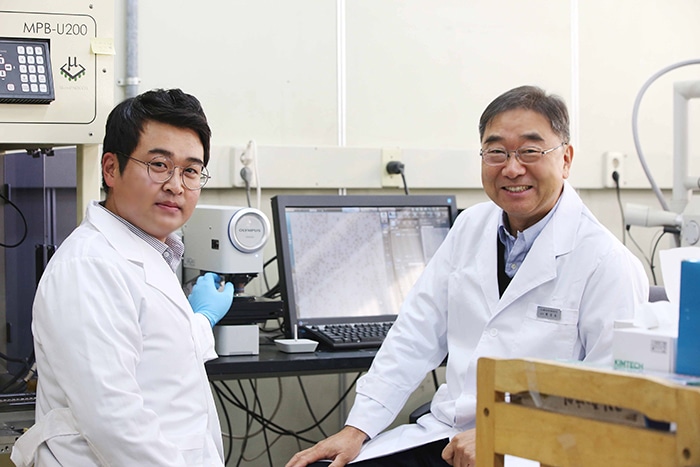Nov 14 2018
Ultra-fine pitch assemblies are increasingly required by higher resolution display electronic devices. In this context, display driver interconnection technology has turned out to be an important challenge for advancing display electronics.
 Professor Paik (right) and PhD Candidate Yoon. (Image credit: KAIST)
Professor Paik (right) and PhD Candidate Yoon. (Image credit: KAIST)
Now, with a novel thermoplastic anchoring polymer layer structure, scientists have moved one step closer to achieving ultra-fine resolution for displays. By effectively preventing the movement of conductive particles, the innovative structure can considerably enhance the ultra-fine pitch interconnection. It is believed that this film can be applied to a wide range of large-sized OLED panels, mobile devices, and VR, to name a few.
Researchers, led by Professor Kyung-Wook Paik in the Department of Materials, have come up with a novel anchoring polymer layer structure that can effectively prevent the movement of conductive particles at the time of the bonding process of the anisotropic conductive films, or ACFs. The novel structure will considerably enhance the capture rate of conductive particles, thereby tackling electrical short issues encountered in the ultra-fine pitch assembly process.
At the time of the ultra-fine pitch bonding process, the conductive particles of traditional ACFs tend to agglomerate between bumps and lead to electrical short circuits. Therefore, higher tensile strength anchoring polymer layers integrated with conductive particles were added to the ACFs so as to resolve the electrical shortage issue induced by the free movement of conductive particles. This was done to effectively suppress the movement of conductive particles.
Nylon was used by the researchers to create one layer film with incorporated and well-distributed conductive particles. It was observed that the nylon’s higher tensile strength fully prevented the conductive particle movement, increasing the conductive particle capture rate from just 33% of the conventional ACFs to a phenomenal 90%.
During the chip-on-glass assembly, the nylon films did not display any short circuit issues, and during the ultra-fine pitch applications, they also acquired high reliability, excellent electrical conductivity, and low-cost ACFs.
In addition to VR, 4K, and 8K UHD display products, this new type of ACFs can also be applied to mobile devices and large-size OLED panels, says Professor Paik.
A prototype of the film has been completed by Paik’s team with support from a domestic company, H&S High-Tech, and the “Innopolis Foundation.” PhD candidate Dal-Jin Yoon is the first author of the study, which was published in the October issue of IEEE TCPMT.